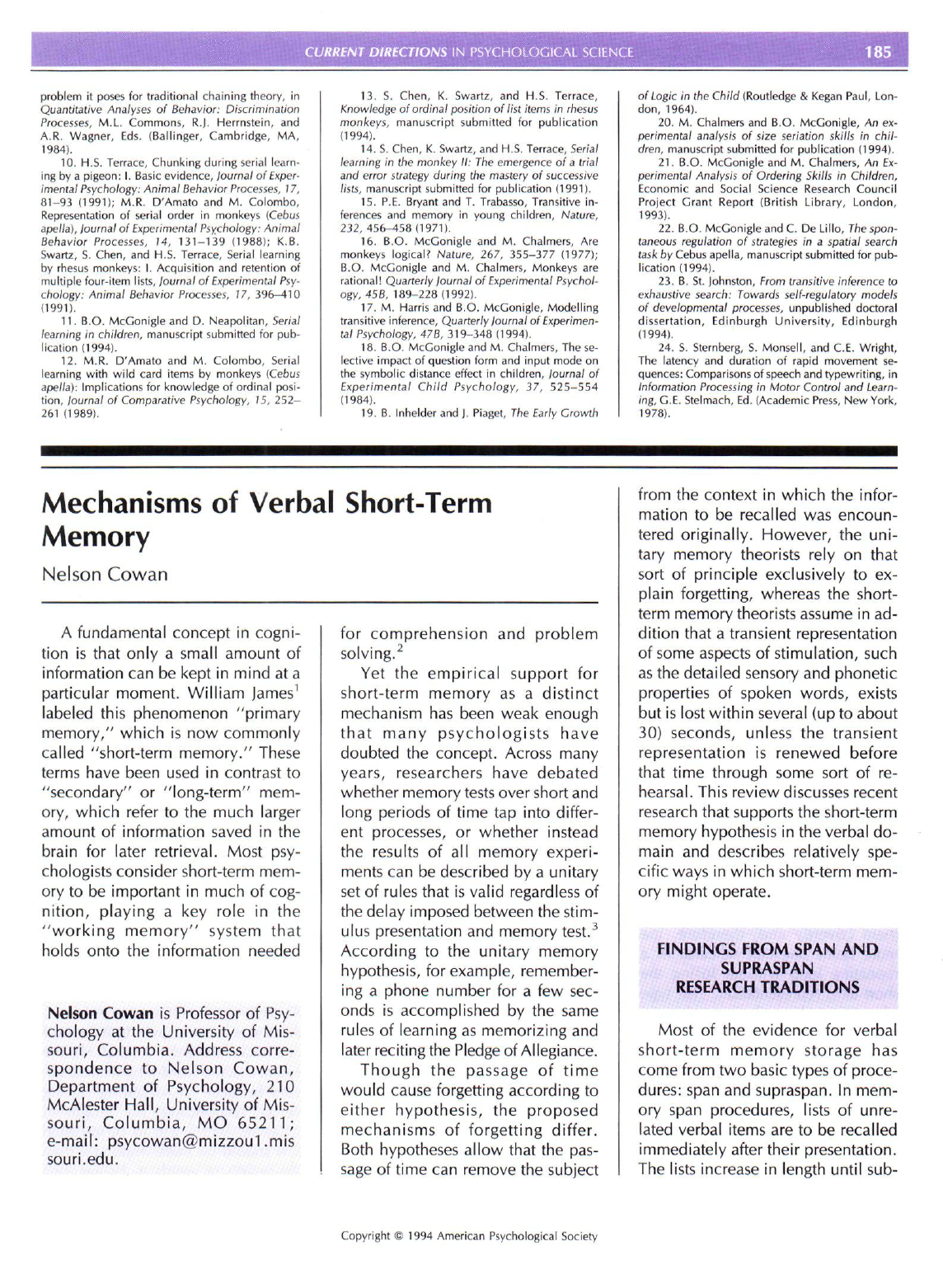
CURRENT DtRECTIONS
iN PSYCHOtCKIICAL SCIENCE
problem it poses for traditional chaining theory, in
Quanl/tat/ve Analyses of Behavior: Discrimination
Processes,
M,L. Commons, R.|. Herrnstein, and
A,R. Wagner, Eds, (Ballinger, Cambridge, MA,
1984),
10.
H,S, Terrace, Chunking during serial learn-
ing by a pigeon: I, Basic evidence, journal of
Exper-
imental
Psychology:
Animal Behavior
Processes,
17,
61-93 (1991); M.R. D'Amato and M, Colombo,
Representation of serial order in monkeys {Cebus
apella),
journal of
Experimental
Psychology: Animal
Behavior Processes, U, 131-139 (1988); K,B,
Swartz, S. Chen, and H,S, Terrace, Serial learning
by rhesus monkeys: I, Acquisition and retention of
multiple four-item lists, journal of
Experimental
Psy-
chology: Animal Behavior
Processes,
17, 396-410
(1991).
11.
B.O. McConigle and D. Neapolitan, 5er/a/
learning in children, manuscript submitted for pub-
lication (1994),
12.
M,R. D'Amatn and M, Colombo, Serial
learning wUh wild card items by monkeys (Cebus
apella).
Implications for knowledge of ordinal
posi-
tion,
journal of Comparative Psychology, 15, 252—
261 (1989),
13.
S, Chen, K, Swartz, and H.S, Terrace,
Knowledge of ordinal position ol list items in
rhesus
monkeys, manuscript submitted for publication
(1994).
14.
S, Chen, K, Swartz, and H,S, Terrace,
Serial
learning in the monkey II: The
emergence
of
a
trial
and error
strategy
during the mastery of
successive
lists, manuscript submitted for publication (1991),
15.
P,E, Bryant and T. Trabasso, Transitive in-
ferences and memory in young children. Nature,
232. 456-^58 (1971),
16.
B,O, McConigle and M, Chalmers, Are
monkeys logical? Nature, 267, 355-^377 (1977);
6,O, McConigle and M. Chalmers, Monkeys are
rational!
Quarterly lournal of
Experimental
Psychol-
ogy, 45B, 189-228(1992),
17.
M. Harris and B.O. McConigle, Modelling
transitive inference. Quarter// lournal of
Experimen-
tal
Psychology,
47B, 319-348 (1994).
18.
B.O. McConigle and M. Chalmers, The se-
lective impact of question form and input mode on
the symbolic distance effect in children, journal of
Experimental
Child
Psychology,
37, 525-554
(1984),
19.
B, Inhelder and
J.
Piaget, The Early Growth
of
Logic
in the Child (Routledge & Kegan Paul, Lon-
don,
1964),
20,
M, Chalmers and B.O. McConigle, An ex-
perimental analysis of size seriation skills in
chil-
dren, manuscript submitted for publication (1994).
21,
B,O, McConigle and M, Chalmers, An Ex-
perimental Analysis of Ordering Skills in Children,
Economic and Social Science Research Council
Project Grant Report (British Library, London,
1993),
22,
B.O, McConigle and C. De Lillo,
The
spon-
taneous regulation of
strategies
in a spatial search
task
by Cebus apella, manuscript submitted for pub-
lication (1994).
23,
B, St. lohnston, from transitive inference to
exhaustive seared; Towards self-regulatory models
of developmental
processes,
unpublished doctoral
dissertation, Edinburgh University, Edinburgh
(1994),
24,
S, Sternberg, S, Monsell, and C.E. Wright,
The latency and duration of rapid movement se-
quences: Comparisons of speech and typewriting, in
information
Processing
in Motor Control and learn-
ing,Ct. Stefmach, Ed, (Academic Press, New York,
1978),
Mechanisms of Verbal Short-Term
Memory
Nelson Cowan
A fundamental concept in cogni-
tion is that only a small amount of
information can be kept in mind at a
particular moment. William James'
labeled this phenomenon "primary
memory," which is now commonly
called "short-term memory." These
terms have been used in contrast to
"secondary" or "long-term" mem-
ory, which refer to the much larger
amount of information saved in the
brain for later retrieval. Most psy-
chologists consider short-term mem-
ory to be important in much of cog-
nition,
playing a key role in the
"working memory" system that
holds onto the information needed
Nelson Cowan is Professor of Psy-
chology at the University of Mis-
souri,
Columbia. Address corre-
spondence to Nelson Cowan,
Department of Psychology, 210
McAlester
Hall,
University of Mis-
souri,
Colunnbia, MO
65211;
e-mail: psycowan@mizzou1 .mis
souri.edu.
for comprehension and problem
solving.^
Yet the empirical support for
short-term memory as a distinct
mechanism has been weak enough
that many psychologists have
doubted the concept. Across many
years,
researchers have debated
whether memory tests over short and
long periods of time tap into differ-
ent processes, or whether instead
the results of all memory experi-
ments can be described by a unitary
set of rules that is valid regardless of
the delay imposed between the stim-
ulus presentation and memory test.^
According to the unitary memory
hypothesis, for example, remember-
ing a phone number for a few sec-
onds is accomplished by the same
rules of learning as memorizing and
later reciting the Pledge of Allegiance.
Though the passage of time
would cause forgetting according to
either hypothesis, the proposed
mechanisms of forgetting differ.
Both hypotheses allow that the pas-
sage of time can remove the subject
from the context in which the infor-
mation to be recalled was encoun-
tered originally. However, the uni-
tary memory theorists rely on that
sort of principle exclusively to ex-
plain forgetting, whereas the short-
term memory theorists assume in ad-
dition that a transient representation
of some aspects of stimulation, such
as the detailed sensory and phonetic
properties of spoken words, exists
but is lost within several (up to about
30) seconds, unless the transient
representation is renewed before
that time through some sort of re-
hearsal.
This review discusses recent
research that supports the short-term
memory hypothesis in the verbal do-
main and describes relatively spe-
cific ways in which short-term mem-
ory might operate.
FINDINGS FROM SPAN AND
SUPRASPAN
RESEARCH TRADITIONS
Most of the evidence for verbal
short-term memory storage has
come from two basic types of proce-
dures:
span and supraspan. In mem-
ory span procedures, lists of unre-
lated verbal items are to be recalled
immediately after their presentation.
The lists increase in length until sub-
Copyright © 1994 American Psychological Society
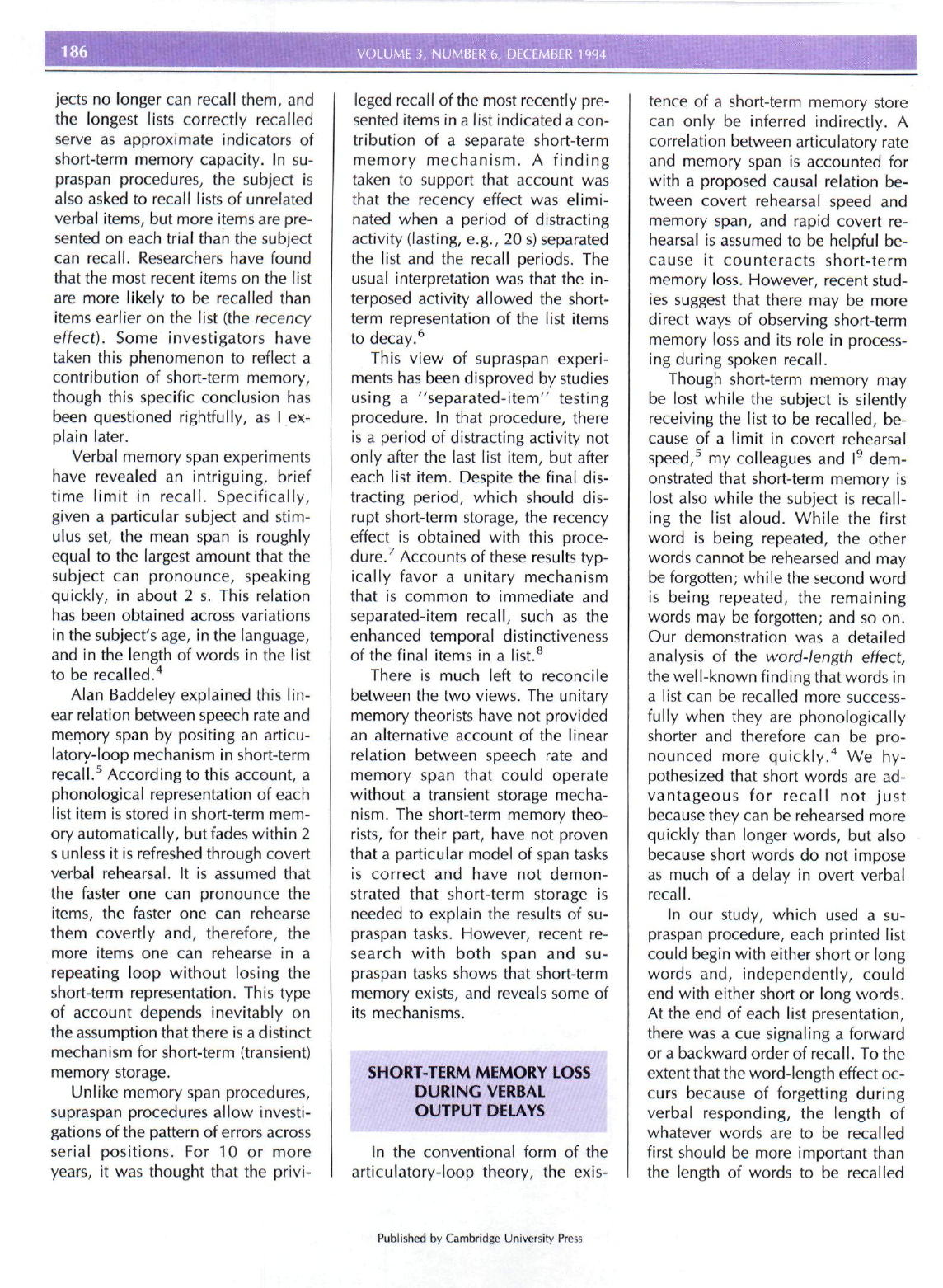
VOlUMh
\^,
NUMBER 6, DECEMBER 1994
jects no longer can recall them, and
the longest lists correctly recalled
serve as approximate indicators of
short-term memory capacity. In su-
praspan procedures, the subject is
also asked to recall lists of unrelated
verbal items, but more items are pre-
sented on each trial than the subject
can recall. Researchers have found
that the most recent items on the list
are more likely to be recalled than
items earlier on the list (the
recer)cy
effect).
Some investigators have
taken this phenomenon to reflect a
contribution of short-term memory,
though this specific conclusion has
been questioned rightfully, as I ex-
plain later.
Verbal memory span experiments
have revealed an intriguing, brief
time limit in recall. Specifically,
given a particular subject and stim-
ulus set, the mean span is roughly
equal to the largest amount that the
subject can pronounce, speaking
quickly, in about 2 s. This relation
has been obtained across variations
in the subject's age, in the language,
and in the length of words in the list
to be recalled."*
Alan Baddeley explained this lin-
ear relation between speech rate and
merpory span by positing an articu-
latory-loop mechanism in short-term
recall.^
According to this account, a
phonological representation of each
list item is stored in short-term mem-
ory automatically, but fades within 2
s
unless it is refreshed through covert
verbal rehearsal. It is assumed that
the faster one can pronounce the
items,
the faster one can rehearse
them covertly and, therefore, the
more items one can rehearse in a
repeating loop without losing the
short-term representation. This type
of account depends inevitably on
the assumption that there is a distinct
mechanism for short-term (transient)
memory storage.
Unlike memory span procedures,
supraspan procedures allow investi-
gations of the pattern of errors across
serial positions. For 10 or more
years,
it was thought that the
privi-
leged recall of the most recently pre-
sented items in a list indicated a con-
tribution of a separate short-term
memory mechanism. A finding
taken to support that account was
that the recency effect was elimi-
nated when a period of distracting
activity (lasting, e.g., 20 s) separated
the list and the recall periods. The
usual interpretation was that the in-
terposed activity allowed the short-
term representation of the list items
to decay.^
This view of supraspan experi-
ments has been disproved by studies
using a "separated-item" testing
procedure. In that procedure, there
is a period of distracting activity not
only after the last list item, but after
each list item. Despite the final dis-
tracting period, which should dis-
rupt short-term storage, the recency
effect is obtained with this proce-
dure.''
Accounts of these results typ-
ically favor a unitary mechanism
that is common to immediate and
separated-item recall, such as the
enhanced temporal distinctiveness
of the final items in a list.^
There is much left to reconcile
between the two views. The unitary
memory theorists have not provided
an alternative account of the linear
relation between speech rate and
memory span that could operate
without a transient storage mecha-
nism.
The short-term memory theo-
rists,
for their part, have not proven
that a particular model of span tasks
is correct and have not demon-
strated that short-term storage is
needed to explain the results of su-
praspan tasks. However, recent re-
search with both span and su-
praspan tasks shows that short-term
memory exists, and reveals some of
its mechanisms.
SHORT-TERM MEMORY LOSS
DURING VERBAL
OUTPUT DELAYS
In the conventional form of the
articulatory-loop theory, the exis-
tence of a short-term memory store
can only be inferred indirectly. A
correlation between articulatory rate
and memory span is accounted for
with a proposed causal relation be-
tween covert rehearsal speed and
memory span, and rapid covert re-
hearsal is assumed to be helpful be-
cause it counteracts short-term
memory loss. However, recent
stud-
ies suggest that there may be more
direct ways of observing short-term
memory loss and its role in process-
ing during spoken recall.
Though short-term memory may
be lost while the subject is silently
receiving the list to be recalled, be-
cause of a limit in covert rehearsal
speed,^
my colleagues and 1^ dem-
onstrated that short-term memory is
lost also while the subject is recall-
ing the list aloud. While the first
word is being repeated, the other
words cannot be rehearsed and may
be forgotten; while the second word
is being repeated, the remaining
words may be forgotten; and so on.
Our demonstration was a detailed
analysis of the word-length effect,
the well-known finding that words in
a list can be recalled more success-
fully when they are phonologicaliy
shorter and therefore can be pro-
nounced more quickly."^ We hy-
pothesized that short words are ad-
vantageous for recall not just
because they can be rehearsed more
quickly than longer words, but also
because short words do not impose
as much of a delay in overt verbal
recall.
In our study, which used a su-
praspan procedure, each printed list
could begin with either short or long
words and, independently, could
end with either short or long words.
At the end of each list presentation,
there was a cue signaling a forward
or a backward order of recall. To the
extent that the word-length effect oc-
curs because of forgetting during
verbal responding, the length of
whatever words are to be recalled
first should be more important than
the length of words to be recalled
Published by Cambridge University Press
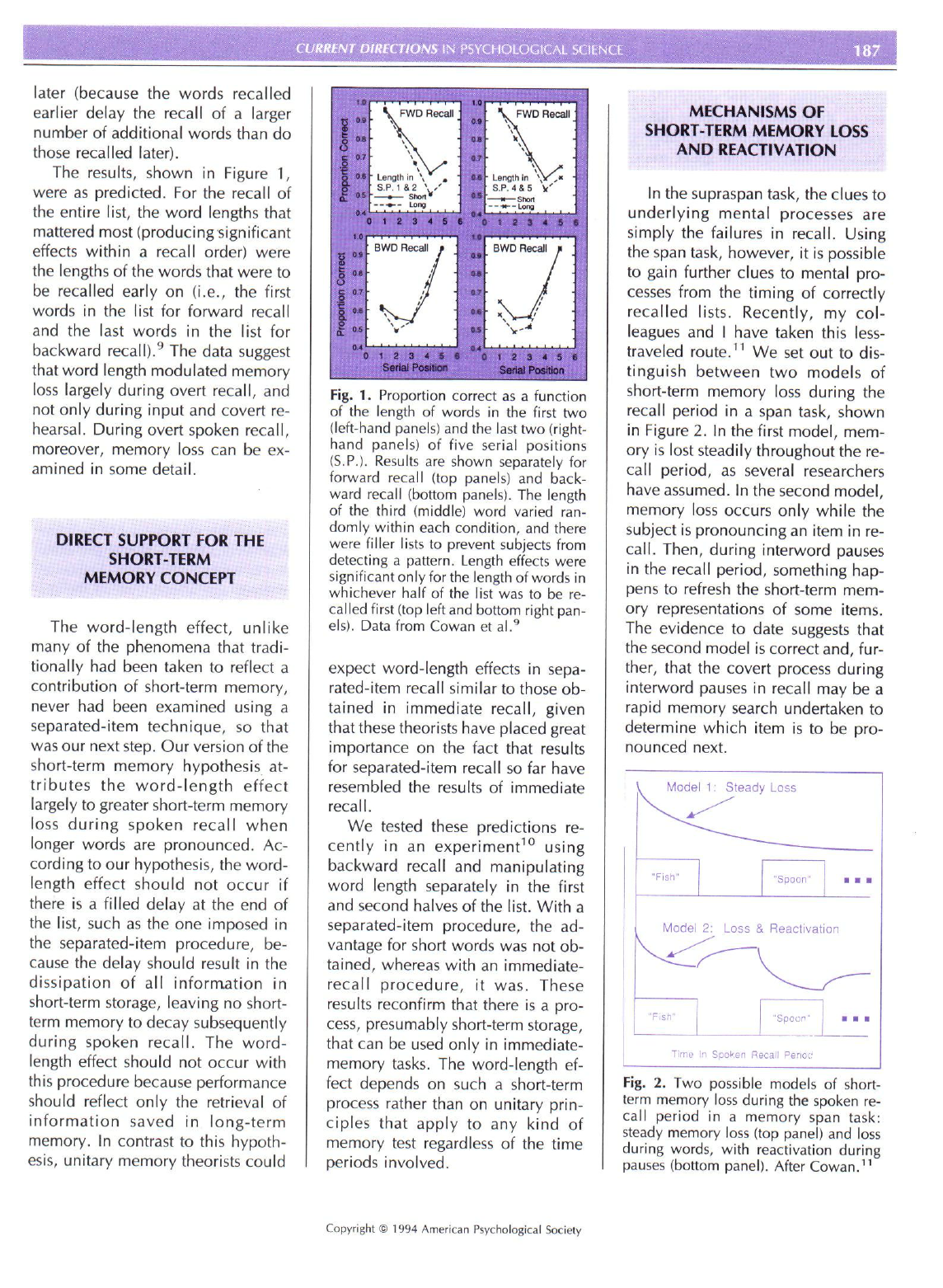
later (because the words recalled
earlier delay the recall of a larger
number of additional words than do
those recalled later).
The results, shown in Figure 1,
were as predicted. For the recall of
the entire list, the word lengths that
mattered most (producing significant
effects within a recall order) were
the lengths of the words that were to
be recalled early on
(i.e.,
the first
words in the list for forward recall
and the last words in the list for
backward recall).^ The data suggest
that word length modulated memory
loss largely during overt recall, and
not only during input and covert re-
hearsal.
During overt spoken recall,
moreover, memory loss can be ex-
amined in some detail.
DIRECT SUPPORT FOR THE
SHORT-TERM
g MEMORY CONCEPT
V
The word-length effect, unlike
many of the phenomena that tradi-
tionally had been taken to reflect a
contribution of short-term memory,
never had been examined using a
separated-item technique, so that
was our next
step.
Our version of the
short-term memory hypothesis at-
tributes the word-length effect
largely to greater short-term memory
loss during spoken recall when
longer words are pronounced. Ac-
cording to our hypothesis, the word-
length effect should not occur if
there is a filled delay at the end of
the list, such as the one imposed in
the separated-item procedure, be-
cause the delay should result in the
dissipation of all inform.ation in
short-term storage, leaving no short-
term memory to decay subsequently
during spoken recall. The word-
length effect should not occur with
this procedure because performance
should reflect only the retrieval of
information saved in long-term
memory. In contrast to this hypoth-
esis,
unitary memory theorists could
Fig.
1. Proportion correct as a function
of the length of words in the first two
(left-hand panels) and the last two (right-
hand panels) of five serial positions
(S.P.).
Results are shown separately for
forward recall (top panels) and back-
ward recall (bottom panels). The length
of the third (middle) word varied ran-
domly within each condition, and there
were filler lists to prevent subjects from
detecting a pattern. Length effects were
significant only for
the
length of
words
in
whichever half of the list was to be re-
called first (top left
and
bottom right pan-
els).
Data from Cowan et al.^
expect word-length effects in sepa-
rated-item recall similar to those ob-
tained in immediate recall, given
that these theorists have placed great
importance on the fact that results
for separated-item recall so far have
resembled the results of immediate
recall.
We tested these predictions re-
cently in an experiment'" using
backward recall and manipulating
word length separately in the first
and second halves of the list. With a
separated-item procedure, the ad-
vantage for short words was not ob-
tained,
whereas with an immediate-
recall procedure, it was. These
results reconfirm that there is a pro-
cess,
presumably short-term storage,
that can be used only in immediate-
memory tasks. The word-length ef-
fect depends on such a short-term
process rather than on unitary
prin-
ciples that apply to any kind of
memory test regardless of the time
periods involved.
MECHANISMS OF
SHORT-TERM MEMORY LOSS
AND REACTIVATION
In the supraspan task, the clues to
underlying mental processes are
simply the failures in recall. Using
the span task, however, it is possible
to gain further clues to mental pro-
cesses from the timing of correctly
recalled lists. Recently, my col-
leagues and I have taken this less-
traveled route." We set out to dis-
tinguish between two models of
short-term memory loss during the
recall period In a span task, shown
in Figure 2. In the first model, mem-
ory is lost steadily throughout the re-
call period, as several researchers
have
assumed.
In the second model,
memory loss occurs only while the
subject is pronouncing an item in re-
call.
Then, during interword pauses
in the recall period, something hap-
pens to refresh the short-term mem-
ory representations of some items.
The evidence to date suggests that
the second model is correct
and,
fur-
ther, that the covert process during
interword pauses in recall may be a
rapid memory search undertaken to
determine which item is to be pro-
nounced next.
Model 1: Steady Loss
Model 2: Loss & Reactivation
Time In Spoken Recall Pence
Fig.
2. Two possible models of short-
term memory loss during the spoken re-
call period in a memory span task:
steady memory loss (top panel) and loss
during words, with reactivation during
pauses (bottom panel). After Cowan.'^
Copyright © 1994 American Psychological Society
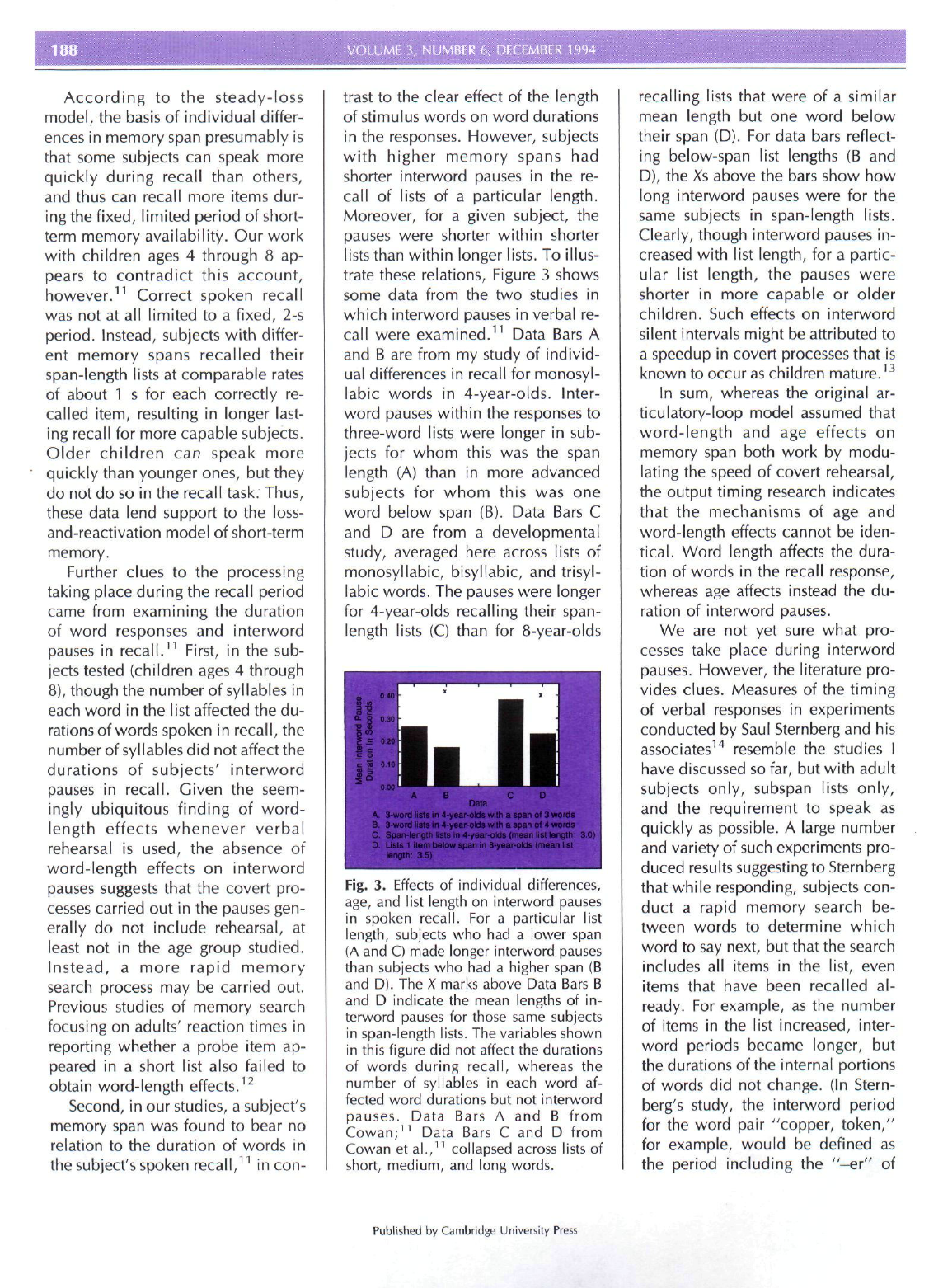
According to the steady-loss
model,
the basis of individual differ-
ences in memory span presumably is
that some subjects can speak more
quickly during recall than others,
and thus can recall more items dur-
ing the fixed, limited period of short-
term memory availability. Our work
with children ages 4 through 8 ap-
pears to contradict this account,
however.^' Correct spoken recall
was not at all limited to a fixed, 2-s
period.
Instead, subjects with differ-
ent memory spans recalled their
span-length lists at comparable rates
of about 1 s for each correctly re-
called item, resulting in longer last-
ing recall for more capable subjects.
Older children can speak more
quickly than younger ones, but they
do not do so in the recall task. Thus,
these data lend support to the loss-
and-reactivation model of short-term
memory.
Further clues to the processing
taking place during the recall period
came from examining the duration
of word responses and interword
pauses in recall.'^ First, in the sub-
jects tested (children ages 4 through
8),
though the number of syllables in
each word in the list affected the du-
rations of words spoken in recall, the
number of syllables did not affect the
durations of subjects' interword
pauses in recall. Given the seem-
ingly ubiquitous finding of word-
length effects whenever verbal
rehearsal is used, the absence of
word-length effects on interword
pauses suggests that the covert pro-
cesses carried out in the pauses gen-
erally do not include rehearsal, at
least not in the age group studied.
Instead,
a more rapid memory
search process may be carried out.
Previous studies of memory search
focusing on adults' reaction times in
reporting whether a probe item ap-
peared in a short list also failed to
obtain word-length effects.'^
Second,
in our studies, a subject's
memory span was found to bear no
relation to the duration of words in
the subject's spoken recall," in con-
trast to the clear effect of the length
of stimulus words on word durations
in the responses. However, subjects
with higher memory spans had
shorter interword pauses in the re-
call of lists of a particular length.
Moreover, for a given subject, the
pauses were shorter within shorter
lists than within longer lists. To illus-
trate these relations. Figure 3 shows
some data from the two studies in
which interword pauses in verbal re-
call were examined." Data Bars A
and B are from my study of individ-
ual differences in recall for monosyl-
labic words in 4-year-olds. Inter-
word pauses within the responses to
three-word lists were longer in sub-
jects for whom this was the span
length (A) than in more advanced
subjects for whom this was one
word below span (B). Data Bars C
and D are from a developmental
study, averaged here across lists of
monosyllabic, bisyllabic, and trisyl-
labic words. The pauses were longer
for 4-year-olds recalling their span-
length lists (C) than for 8-year-olds
Data
A. 3-word lists In 4-year-oldE with a span of 3 words
B. 3-word lists in 4'year'Olds with a span ol 4 words
C. Span-length lists in 4-year-olds (mean list langtti: 3(
D. Lists I item tielow span in B-year-olds (mean list
Fig.
3. Effects of individual differences,
age,
and list length on interword pauses
in spoken recall. For a particular list
length,
subjects who had a lower span
(A
and
C) made longer interword pauses
than subjects who had a higher span (B
and D). The X marks above Data Bars B
and D indicate the mean lengths of in-
terword pauses for those same subjects
in span-length lists.
The
variables shown
in this figure did not affect the durations
of words during recall, whereas the
number of syllables in each word af-
fected word durations but not interword
pauses. Data Bars A and B from
Cowan;"
Data Bars C and D from
Cowan et al.," collapsed across lists of
short, medium, and long words.
recalling lists that were of a similar
mean length but one word below
their span (D). For data bars reflect-
ing below-span list lengths (B and
D),
the Xs above the bars show how
long interword pauses were for the
same subjects in span-length lists.
Clearly, though interword pauses in-
creased with list length, for a partic-
ular list length, the pauses were
shorter in more capable or older
children.
Such effects on interword
silent intervals might be attributed to
a speedup in covert processes that is
known to occur
as
children mature.^^
In sum, whereas the original ar-
ticulatory-loop model assumed that
word-length and age effects on
memory span both work by modu-
lating the speed of covert rehearsal,
the output timing research indicates
that the mechanisms of age and
word-length effects cannot be
iden-
tical.
Word length affects the dura-
tion of words in the recall response,
whereas age affects instead the du-
ration of interword pauses.
We are not yet sure what pro-
cesses take place during interword
pauses. However, the literature pro-
vides clues. Measures of the timing
of verbal responses in experiments
conducted by Saul Sternberg and his
associates'"^ resemble the studies I
have discussed so far, but with adult
subjects only, subspan lists only,
and the requirement to speak as
quickly as possible. A large number
and variety of
such
experiments pro-
duced results suggesting to Sternberg
that while responding, subjects con-
duct a rapid memory search be-
tween words to determine which
word to say next, but that the search
includes all items in the list, even
items that have been recalled al-
ready. For example, as the number
of items in the list increased, inter-
word periods became longer, but
the durations ofthe internal portions
of words did not change. (In Stern-
berg's study, the interword period
for the word pair "copper, token,"
for example, would be defined as
the period including the "-er" of
Published by Cambridge University Press
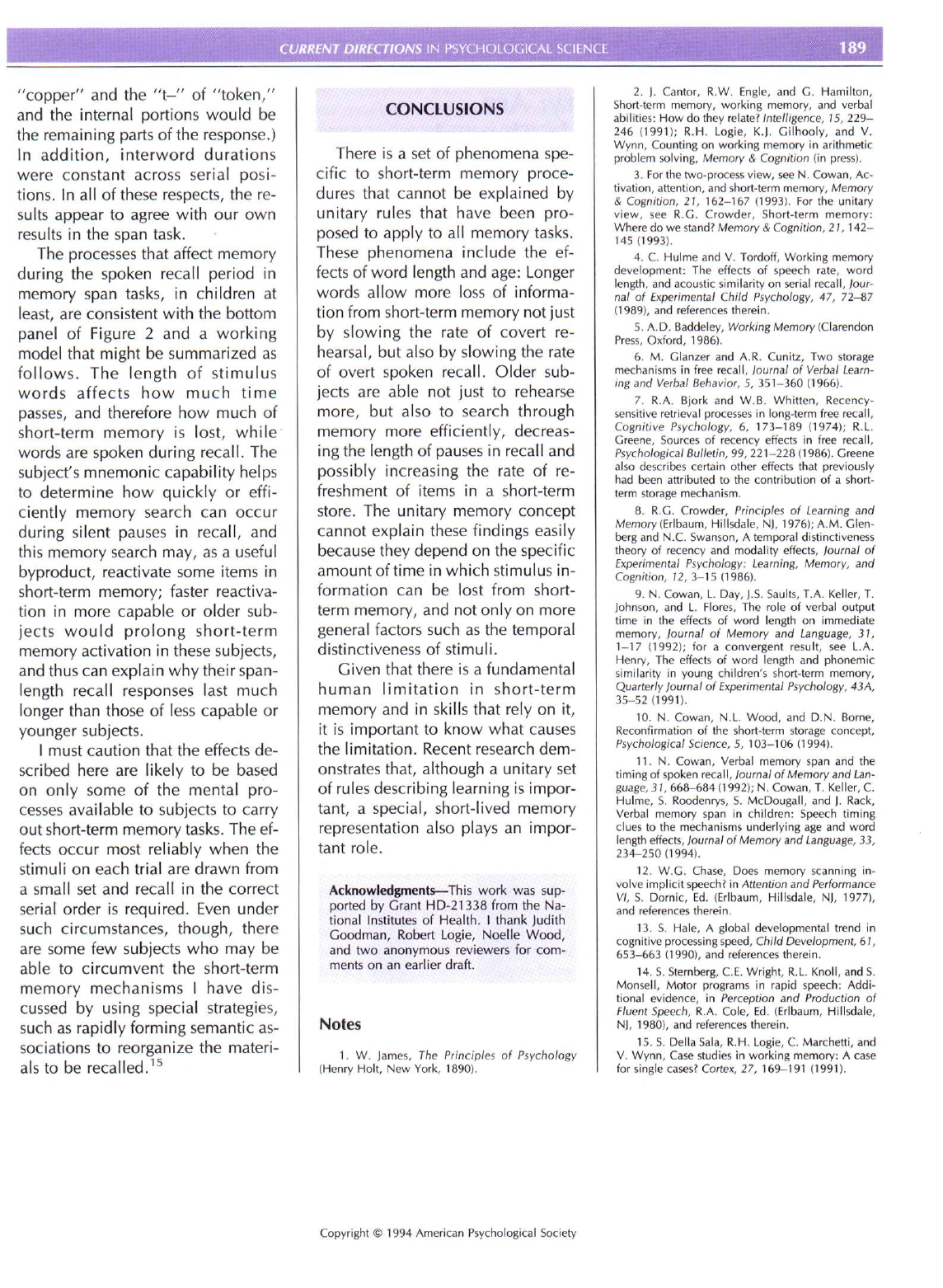
CURRENT
OmCTlONS iN PSYCHOLOGICAL SCIENCE
"copper" and the "t-" of "token,"
and the internal portions would be
the remaining parts ofthe response.)
In addition, interword durations
were constant across serial
posi-
tions.
In all of these respects, the re-
sults appear to agree with our own
results in the span task.
The processes that affect memory
during the spoken recall period in
memory span tasks, in children at
least, are consistent with the bottom
panel of Figure 2 and a working
model that might be summarized as
follows. The length of stimulus
words affects how much time
passes, and therefore how much of
short-term memory is lost, while
words are spoken during recall. The
subject's mnemonic capability helps
to determine how quickly or
effi-
ciently memory search can occur
during silent pauses in recall, and
this memory search may, as a useful
byproduct, reactivate some items in
short-term memory; faster reactiva-
tion in more capable or older sub-
jects would prolong short-term
memory activation in these subjects,
and thus can explain why their span-
length recall responses last much
longer than those of less capable or
younger subjects.
I must caution that the effects de-
scribed here are likely to be based
on only some of the mental pro-
cesses available to subjects to carry
out short-term memory tasks. The ef-
fects occur most reliably when the
stimuli on each trial are drawn from
a small set and recall in the correct
serial order is required. Even under
such circumstances, though, there
are some few subjects who may be
able to circumvent the short-term
memory mechanisms I have dis-
cussed by using special strategies,
such as rapidly forming semantic as-
sociations to reorganize the materi-
als to be recalled.'^
CONCLUSIONS
There is a set of phenomena spe-
cific to short-term memory proce-
dures that cannot be explained by
unitary rules that have been pro-
posed to apply to all memory tasks.
These phenomena include the ef-
fects of word length and age: Longer
words allow more loss of informa-
tion from short-term memory not just
by slowing the rate of covert re-
hearsal,
but also by slowing the rate
of overt spoken recall. Older sub-
jects are able not just to rehearse
more,
but also to search through
memory more efficiently, decreas-
ing the length of pauses in recall and
possibly increasing the rate of re-
freshment of items in a short-term
store.
The unitary memory concept
cannot explain these findings easily
because they depend on the specific
amount of time in which stimulus in-
formation can be lost from short-
term memory, and not only on more
general factors such as the temporal
distinctiveness of stimuli.
Given that there is a fundamental
human limitation in short-term
memory and in skills that rely on it,
it is important to know what causes
the limitation. Recent research dem-
onstrates that, although a unitary set
of rules describing learning is impor-
tant, a special, short-lived memory
representation also plays an impor-
tant role.
Acknowledgments—This work was sup-
ported by Grant HD-21 338 from the Na-
tional Institutes of Health. I thank Judith
Goodman,
Robert Logie, Noelle Wood,
and two anonymous reviewers for com-
ments on an earlier draft.
Notes
1.
W. Jafne5, The Principles of Psychology
(Henry Holt, New York, 1890).
2.
). Cantor, R.W. Engle, and G. Hamilton,
Short-term memory, working memory, and verbal
abilities: How do they relate? Intelligence, 15, 229-
246 (1991): R.H. Logie, K.J. Gilhooly, and V.
Wynn,
Counting on working memory in arithmetic
problem solving, Memory & Cognition (in press).
3. For the two-process view, see N. Cowan, Ac-
tivation,
attention, and shor!-lerm memorv. Memory
& Cognition, 2!, 162-167 (1993). For the unitary
view, see R.G. Crowder, Short-term memory:
Where do we stand? Memory & Cognition, 21, 142-
145 (1993).
4.
C. Hulme and V. Tordoff, Working memory
development: The effects of speech rate, word
length,
and acoustic similarity on serial recali,
lour-
nai of Experimental Child Psychology, 47, 72-87
(1989), and references therein.
5. A.D. Baddeley, Working Memory (Clarendon
Press, Oxford, 1986).
6. M. Glanzer and A.R. Cunitz, Two storage
mechanisms in free recall, journal of Verbal Learn-
ing and Verbal Behavior, 5, 351-360 (1966).
7. R.A. Bjork and W.B. Whitten, Recency-
sensitive retrieval processes in long-term free recall,
Cogn/I/ve Psychology, 6, 173-189 (1974); R.L.
Greene, Sources of recency effects in free recall.
Psychological Bulletin, 99. 221-228 (1986). Greene
also describes certain other effects that previously
had been attributed to the contribution of a short-
term storage mechanism.
8. R.G. Crowder, Principles of Learning and
Memory (Erlbaum, Hillsdale, N), 1976); A.M. Glen-
berg and N.C. Swanson, A temporal distinctiveness
theory of recency and modality effects, journal of
Experimental Psychology: Learning, Memory, and
Cognition, 12, 3-15 (1986).
9. N. Cowan, L. Day, J.S. Saults, T.A. Keller, T.
Johnson,
and L. Flores, The role of verbal output
time in the effects of word length on immediate
memory, joumal of Memory and Language, 31,
1-17 (1992); for a convergent result, see L.A.
Henry, The effects of word length and phonemic
similarity in young children's short-term memory.
Quarterly joumal of
Experimental
Psychology, 43A,
35-52 (1991).
10.
N, Cowan, N.L, Wood, and D.N. Borne,
Reconfirmation of the short-term storage concept,
Psyc/io/ogical Science, 5, 103-106 (1994).
11.
N. Cowan, Verbal memory span and the
timing of spoken recall, lotimal of Memory and
Lan-
guage,
31, 668-684 (1992); N. Cowan, T. Keller, C.
Hulme, S. Roodenrvs, S. McDougall, and |. Rack,
Verbal memory span in children: Speech timing
clues to the mechanisms underlying age and word
length effects, journal of Memory and
Language,
33,
234-250(19941.
12.
W.G. Chase, Does memory scanning in-
volve implicit speech? in Attention and
Performance
VI, S. Dornic, Ed. (Erlbaum, Hillsdale, NJ, 1977),
and references therein.
13.
S. Hale, A global developmental trend in
cognitive processing
speed.
Child Development, 6J,
653-663 (1990), and references therein.
14.
S. Sternberg, C.E, Wright, R.L. Knoll, and S,
Monsell,
Motor programs in rapid speech; Addi-
tional evidence, in Perception and Production of
Fluent
Speech,
R.A. Cole, Ed. (Ertbaum, Hillsdale,
NJ,
1980), and references therein.
15-
S. Delta Sala, R.H. Logie, C. Marchetti, and
V. Wynn, Case studies in working memory: A case
for single cases? Cortex, 27, 169-191 (1991),
Copyright © 1994 American Psychological Society

